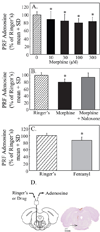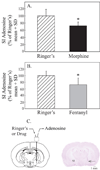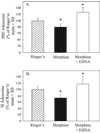Opioid-induced decreases in rat brain adenosine levels are reversed by inhibiting adenosine deaminase
- PMID: 19934879
- PMCID: PMC2784661
- DOI: 10.1097/ALN.0b013e3181bdf894
Opioid-induced decreases in rat brain adenosine levels are reversed by inhibiting adenosine deaminase
Abstract
Background: Opioids disrupt sleep and adenosine promotes sleep, but no studies have characterized the effects of opioids on adenosine levels in brain regions known to regulate states of arousal. Delivering opioids to the pontine reticular formation (PRF) and substantia innominata (SI) region of the basal forebrain disrupts sleep. In contrast, administering adenosine agonists to the PRF or SI increases sleep. These findings encouraged the current study testing the hypothesis that microdialysis delivery of opioids to the PRF or SI decreases adenosine levels in the PRF or SI, respectively.
Methods: A microdialysis probe was placed in the PRF of isoflurane anesthetized rats and perfused with Ringer's solution (control) followed by Ringer's solution containing morphine (0, 10, 30, 100, or 300 microm), fentanyl (100 microm), morphine (100 microm) and the adenosine deaminase inhibitor EHNA (100 microm), or naloxone (10 microm) and morphine (100 microm). Additional experiments measured adenosine levels in the SI before and during microdialysis delivery of morphine, fentanyl, and morphine plus EHNA.
Results: Morphine caused a significant (P < 0.05) concentration-dependent decrease in PRF adenosine levels. The significant decrease (-20%) in adenosine caused by 100 microm morphine was blocked by coadministration of naloxone. Fentanyl also significantly decreased (-13.3%) PRF adenosine. SI adenosine levels were decreased by morphine (-26.8%) and fentanyl (-27.4%). In both PRF and SI, coadministration of morphine and EHNA prevented the significant decrease in adenosine levels caused by morphine alone.
Conclusions: These data support the interpretation that decreased adenosine levels in sleep-regulating brain regions may be one of the mechanisms by which opioids disrupt sleep.
Conflict of interest statement
Figures




Comment in
-
Opiates, sleep, and pain: the adenosinergic link.Anesthesiology. 2009 Dec;111(6):1175-6. doi: 10.1097/ALN.0b013e3181bdfa2e. Anesthesiology. 2009. PMID: 19934853 Free PMC article. No abstract available.
Similar articles
-
Buprenorphine disrupts sleep and decreases adenosine concentrations in sleep-regulating brain regions of Sprague Dawley rat.Anesthesiology. 2011 Oct;115(4):743-53. doi: 10.1097/ALN.0b013e31822e9f85. Anesthesiology. 2011. PMID: 21857500 Free PMC article.
-
Sleep and GABA levels in the oral part of rat pontine reticular formation are decreased by local and systemic administration of morphine.Neuroscience. 2007 Jan 5;144(1):375-86. doi: 10.1016/j.neuroscience.2006.09.007. Epub 2006 Oct 19. Neuroscience. 2007. PMID: 17055662 Free PMC article.
-
Fentanyl and morphine, but not remifentanil, inhibit acetylcholine release in pontine regions modulating arousal.Anesthesiology. 1999 Apr;90(4):1070-7. doi: 10.1097/00000542-199904000-00021. Anesthesiology. 1999. PMID: 10201679
-
Morphine inhibits acetylcholine release in rat prefrontal cortex when delivered systemically or by microdialysis to basal forebrain.Anesthesiology. 2005 Oct;103(4):779-87. doi: 10.1097/00000542-200510000-00016. Anesthesiology. 2005. PMID: 16192770
-
Microdialysis delivery of morphine to the hypoglossal nucleus of Wistar rat increases hypoglossal acetylcholine release.Sleep. 2007 May;30(5):566-73. doi: 10.1093/sleep/30.5.566. Sleep. 2007. PMID: 17552371
Cited by
-
Disrupted sleep and delayed recovery from chronic peripheral neuropathy are distinct phenotypes in a rat model of metabolic syndrome.Anesthesiology. 2010 Nov;113(5):1176-85. doi: 10.1097/ALN.0b013e3181f56248. Anesthesiology. 2010. PMID: 20938334 Free PMC article.
-
Hyperactivity, dopaminergic abnormalities, iron deficiency and anemia in an in vivo opioid receptors knockout mouse: Implications for the restless legs syndrome.Behav Brain Res. 2019 Nov 18;374:112123. doi: 10.1016/j.bbr.2019.112123. Epub 2019 Jul 31. Behav Brain Res. 2019. PMID: 31376441 Free PMC article.
-
The prevalences of and association between nonmedical prescription opioid use and poor sleep among Chinese high school students.Sci Rep. 2016 Jul 28;6:30411. doi: 10.1038/srep30411. Sci Rep. 2016. PMID: 27467181 Free PMC article.
-
Allosteric Interactions between Adenosine A2A and Dopamine D2 Receptors in Heteromeric Complexes: Biochemical and Pharmacological Characteristics, and Opportunities for PET Imaging.Int J Mol Sci. 2021 Feb 9;22(4):1719. doi: 10.3390/ijms22041719. Int J Mol Sci. 2021. PMID: 33572077 Free PMC article. Review.
-
Factors Associated with Sleep Disorders among Methadone-Maintained Drug Users in Vietnam.Int J Environ Res Public Health. 2019 Nov 6;16(22):4315. doi: 10.3390/ijerph16224315. Int J Environ Res Public Health. 2019. PMID: 31698771 Free PMC article.
References
-
- Lydic R, Baghdoyan HA. In: Neurochemical mechanisms mediating opioid-induced REM sleep disruption, Sleep and Pain. Lavigne G, Sessle BJ, Choinière M, Soja PJ, editors. Seattle: International Association for the Study of Pain (IASP) Press; 2007. pp. 99–122.
-
- Roehrs T, Roth T. Sleep and pain: Interaction of two vital functions. Semin Neurol. 2005;25:106–116. - PubMed
-
- Kundermann B, Krieg JC, Schreiber W, Lautenbacher S. The effect of sleep deprivation on pain. Pain Res Manag. 2004;9:25–32. - PubMed
-
- Gallagher RM, Rosenthal LJ. Chronic pain and opiates: Balancing pain control and risks in long-term opioid treatment. Arch Phys Med Rehabil. 2008;89:S77–S82. - PubMed
Publication types
MeSH terms
Substances
Grants and funding
LinkOut - more resources
Full Text Sources
Other Literature Sources
Medical
Molecular Biology Databases
Research Materials

